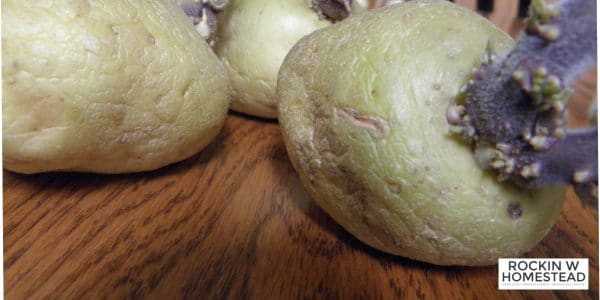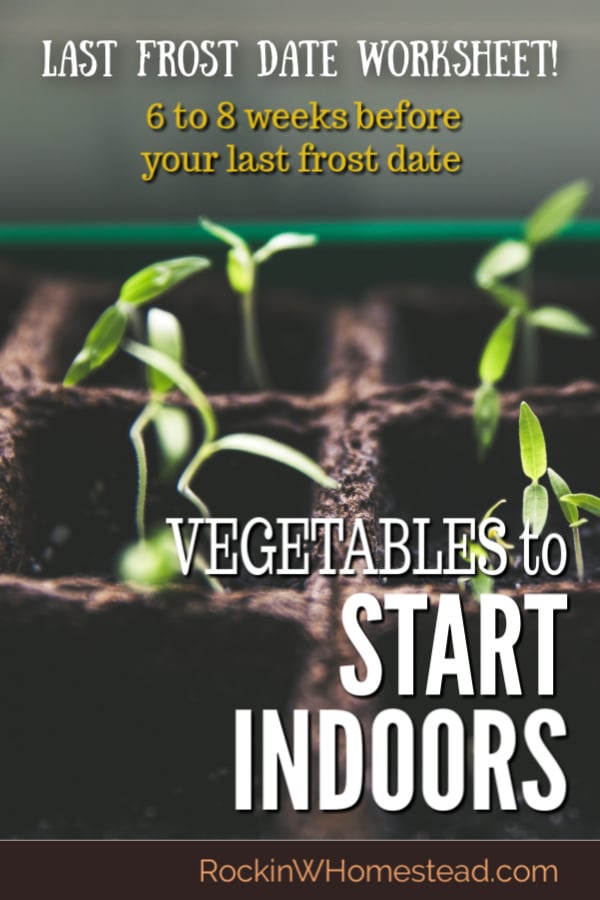We’ve taken the guesswork out of your planting schedule! Get ready for the gardening season and use this guide to know what to plant indoors 6 to 8 weeks before your last frost date. 
In the past, I would often miss my seed starting dates and then end up purchasing plants from the local nursery or big box store. If you don; thave the time to start seeds, there’s nothing wrong with purchasing plants – but if you want to grow a big garden or are looking for ways to cut down n the cost, starting your own seeds is the answer.
I’ve made you a handy list of the common vegetables that will benefit from planting indoors 6 to 8 weeks before your last frost date. Some of these plants (tomatoes and peppers) need a start indoors so they can get bigger before they are planted outside when it is warm. Others are cool weather crops that can benefit from a protected start until your garden is ready for them.
Vegetables to Start from Seed 6 to 8 Weeks Before Your Last Frost Date
Cabbage can be sown early in small pots 1/2 an inch deep. Harden off seedlings by setting out for a few hours each day. Transplant outdoors when 3 to 6 inches tall, on 12-inch centers.
Artichoke does well in warm climates, but in cold climates starting seed indoors is a must. Grow as an annual or grow in pots and overwinter indoors.
Leek needs a long growing season. Plant early for a summer harvest and again in the fall for overwintering.
Parsley likes full sun or light shade and moist rich soil with plenty of organic matter. Soak the seeds overnight to speed up germination (which can take up to 3 weeks). Choose your garden spot carefully and let one plant go to seed in the fall. It will come up again, year after year.
Sweet or Hot Peppers need heat to grow and set fruit and nighttime temps below 50F will stunt seedlings.
Tomatillos are grown just like tomatoes and are used in soups and sauces. Harden your tomatillo plants when the weather reaches 50F and consistently stays that way at night. Grow tomatillo plants in tomato cages or by themselves. If you do put them in cages, set the plants 2 feet apart, or if you want to let them sprawl, set them 3 feet apart.
A tomato needs warm weather to grow and produce fruit. The blossoms will fall off below 50F. Find varieties suitable to your climate. Sow seeds in flats or small containers. Keep them warm and moist until they sprout, about 6 to 14 days.
Rhubarb can be found as starts at your local nursery or grow the variety “Glaskins Perpetual” from seed. It can be grown in any climate, under just about any conditions. Rhubarb prefers a hard freeze during winter, but it’s not necessary.

Potatoes are started from sprouts on last year’s crop 6 to 8 weeks before the last frost. Purchase specialty, organic spuds and try sprouting them yourself or get seed potatoes from a local nursery. Start indoors, cut into sections with at least one eye and plant out in the garden (or in pots) 3 weeks before the last frost date.
The Best Containers for Seed Starting
I tend to do my seeds with as little expense as possible. This leads me to choose reusable and recycled seed starting containers as much as possible. I have also used eco-friendly grow bags that can be planted directly in the soil. This cuts down on transplanting and disturbing the roots of the new seedlings.
I sourced Bio-degradable Seedling Grow Bags and have them in my online store at Lazy Pecan. They come in packages of 100, so there is plenty for this year and next.
Related Articles:
6 Vegetables to start from seed 8 to 12 weeks before your last frost date
Vegetables to start from seed 4 to 6 weeks before your last frost date
Vegetables to start from seed 3 to 4 weeks before your last frost date
How do I know my last frost date?
I’ve created a handy worksheet to help you determine your last frost date and how to use this to know when you should start specific seeds indoors. This will also help you decide on the best time to plant them outside in the garden.
Get the Frost Date Planting Worksheet
Don’t worry if you’ve missed the seed starting date, there is often still a window of time to get started. If it is not too far gone, start the seeds anyway. Most cool-weather crops can be planted in succession until the days get very hot during the summer months.
If it is getting on in the season, purchasing starts from the local nursery may be your best option this year.
The Last Frost Date Planting Worksheet works to help you know when to plant certain vegetables and herbs in your garden without danger of frost damage. Enjoy!
Now that you’ve determined your last frost date, what should you be planting right now?



Great information. I work with a really short growing season, so starting seeds indoors helps me out a lot. I didn’t do it last year, but I am planning on doing it this year to help give everything a jumpstart.
That jumpstart is so important!